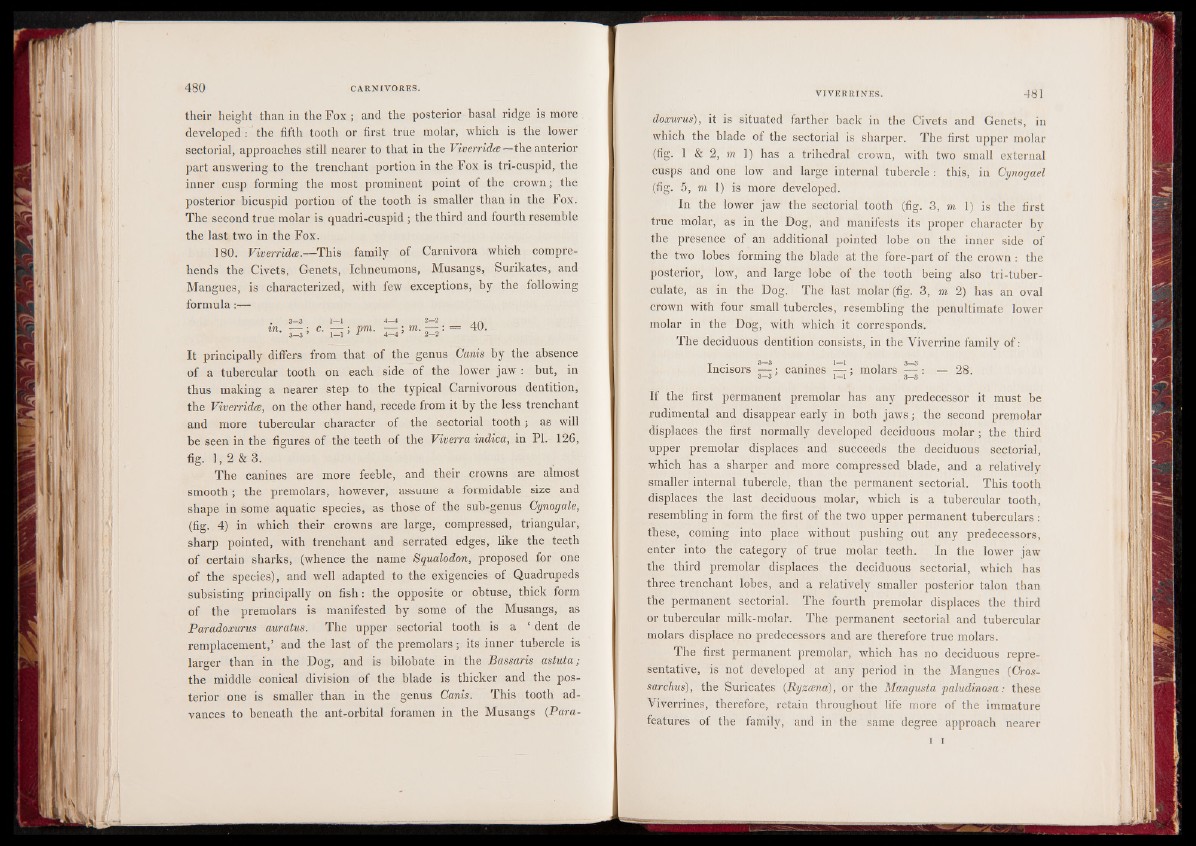
their height than in the Fox ; and the posterior basal ridge is more
developed" the fifth tooth or first true molar, which is the lower
sectorial, approaches still nearer to that in the Viverridce—the anterior
part answering to the trenchant portion in the Fox is tri-cuspid, the
inner cusp forming the most prominent point of the crown; the
posterior bicuspid portion of the tooth is smaller than in the Fox.
The second true molar is quadri-cuspid ; the third and fourth resemble
the last two in the Fox.
180. Viverridce.—This family of Carnivora which comprehends
the Civets, Genets, Ichneumons, Musangs, Surikates, and
Mangues, is characterized, with few exceptions, by the following
formula
1—1 4—4 c- ■ Pm• 2—2
It principally differs from that of the genus Canis by the absence
of a tubercular tooth on each side of the lower jaw : but, in
thus making a nearer step to the typical Carnivorous dentition,
the Viverridce, on the other hand, recede from it by the less trenchant
and more tubercular character of the sectorial tooth; as will
be seen in the figures of the teeth of the Viverra indica, in PI. 126,
fig. 1, 2 &3.
The canines are more feeble, and their crowns are almost
smooth; the premolars, however, assume a formidable size and
shape ip some aquatic species, as those of the sub-genus Cynogale,
(fig. 4) in which their crowns are large, compressed, triangular,
sharp pointed, with trenchant and serrated edges, like the teeth
of certain sharks, (whence the name Squalodon, proposed for one
of the species), and well adapted to the exigencies of Quadrupeds
subsisting principally on fish: the opposite or obtuse, thick form
of the premolars is manifested by some of the Musangs, as
Paradoxurus auratus. The upper sectorial tooth is a ‘ dent de
remplacement,’ and the last of the premolars; its inner tubercle is
larger than in the Dog, and is bilobate in the Bassaris astuta;
the middle conical division of the blade is thicker and the posterior
one is smaller than in the genus Canis. This tooth advances
to beneath the ant-orbital foramen in the Musangs (Para-
VIVERRINES. 481
doxurus), it is situated farther back in the Civets and Genets, in
which the blade of the sectorial is sharper. The first upper molar
(fig. 1 & 2, m 1) has a trihedral crown, with two small external
cusps and one low and large internal tubercle f this, in Cynogael
(fig. 5, m 1) is more developed.
In the lower jaw the sectorial tooth (fig. 3, m 1) is the first
true molar, as in the Dog, and manifests its proper character by
the presence of an additional pointed lobe on the inner side of
the two lobes forming the blade at the fore-part of the crown : the
posterior, low, and large lobe of the tooth being also tri-tuber-
culate, as in the Dog. The last molar (fig. 3, m 2) has an oval
crown with four small tubercles, resembling the penultimate lower
molar in the Dog, with which it corresponds.
The deciduous dentition consists, in the Viverrine family of:
Incisors — ; caninesKisll molars — : = 2 8 .
If the first permanent premolar has any predecessor it must be
rudimental and disappear early in both jaws; the second premolar
displaces the first normally developed deciduous molar; the third
upper premolar displaces and succeeds the deciduous sectorial,
which has a sharper and more compressed blade, and a relatively
smaller internal tubercle, than the permanent sectorial. This tooth
displaces the last deciduous molar, which is a tubercular tooth,
resembling in form the first of the two upper permanent tuberculars:
these, coming into place without pushing out any predecessors,
enter into the category of true molar teeth. In the lower jaw
the third premolar displaces the deciduous sectorial, which has
three trenchant lobes, and a relatively smaller posterior talon than
the permanent sectorial. The fourth premolar displaces the third
or tubercular milk-molar. The permanent sectorial and tubercular
molars displace no predecessors and are therefore true molars.
The first permanent premolar, which has no deciduous representative,
is not developed at any period in the Mangues (Oos-
sarchus), the Suricates {Ryzeena), or the Mangusta paludinosa: these
Viverrines, therefore, retain throughout life more of the immature
features of the family, and in the same degree approach nearer
i i